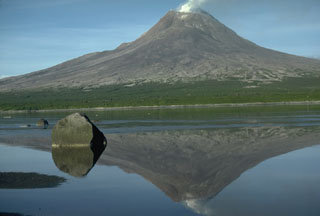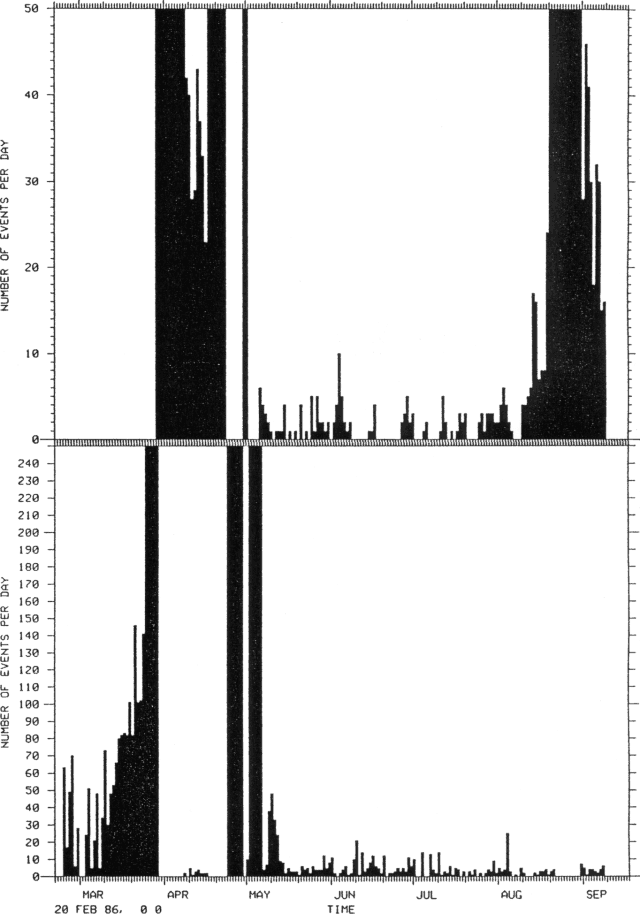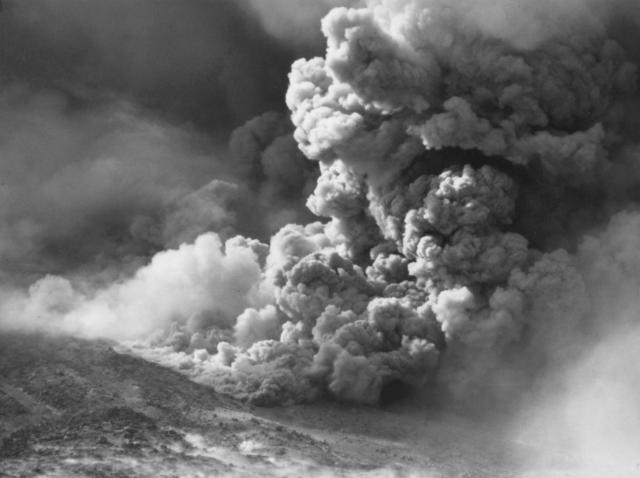Report on Augustine (United States) — August 1986
Scientific Event Alert Network Bulletin, vol. 11, no. 8 (August 1986)
Managing Editor: Lindsay McClelland.
Augustine (United States) Dome growth; pyroclastic flows observed from close range
Please cite this report as:
Global Volcanism Program, 1986. Report on Augustine (United States) (McClelland, L., ed.). Scientific Event Alert Network Bulletin, 11:8. Smithsonian Institution. https://doi.org/10.5479/si.GVP.SEAN198608-313010
Augustine
United States
59.3626°N, 153.435°W; summit elev. 1218 m
All times are local (unless otherwise noted)
The following is from Juergen Kienle. "Augustine was in moderate eruption from about 19-31 August. Renewed dome growth resulted in intense pyroclastic flow activity and plumes rose to 2,500-3,000 m. On 28 August, Maurice and Katia Krafft and Juergen Kienle observed many pyroclastic flows at close range. Incandescent samples of a newly extruded spine were collected by Tom Miller and Kienle on 11 September. The following is a summary of preliminary field observations.
Observations from overflights and fishing boats. "Bill DeCreft, a local bush pilot, reported ash in the air during the evening of 19 August, with unusually pink sunsets. The onset of activity coincided with the full moon, the peak range of the fortnightly earth and ocean tides. On 20 August, DeCreft observed two new pyroclastic flow lobes extending 3/4 of the way down the N and NE flanks. Light brown dust was trailing SE to Cape Douglas, 50 km away. Other pilots reported plumes to 3000 m. That evening (2030-2100), the crew of a fishing boat NW of the volcano observed incandescent pyroclastic flows descending the northern flanks of the volcano. At noon the next day, Tom Miller overflew the mountain and reported very modest ash emissions to a few hundred meters above the vent.
"Poor weather prevented observations 22-23 August, when ash and muddy rain fell at Homer, 100 km to the E. Glow was seen from a fishing boat on 25 August. Miller overflew the volcano again 27-28 August, observing pyroclastic flows and small eruption clouds that rose to 1,000-2,000 m above the volcano. The summit was partially obscured by orographic clouds.
Seismicity. "Figure 15 shows daily surface events (pyroclastic flow counts) and earthquakes (M > 0.25), March-September 1986. Earthquake activity had declined dramatically since the end of the major 27 March-early May eruptive phase. From May through August, seismicity has been very low; we typically recorded fewer than 5 events/day, occasionally up to 20/day. No buildup of seismicity preceded the present dome growth episode. However, it should be noted that during periods of intense avalanching or pyroclastic flow activity, the seismic background noise is so high that we cannot recognize individual microearthquakes.
"Throughout the summer, Merapi-type pyroclastic flows or rockfall avalanches occurred at a rate of less than 10/day. Starting on 13-14 August, we noticed a decided increase in surface events, with more than 50 events counted daily between 21 and 31 August. As of 13 September, the surface event activity had declined to the low summer background level.
Pyroclastic flows. "On 28 and 29 August, Maurice and Katia Krafft and Juergen Kienle visited Augustine Island. On 28 August, the ash plume reached about 2,500 m and prevailing winds carried it to uninhabited areas NW of the volcano. The entire W, N, and E slopes were heavily covered with wet ash all the way to the beach. Leaves and wildflowers were wilted brown from heavy ash accumulation and passage of SO2 clouds. During the day, we managed to observe many pyroclastic flows at close range; figure 16 shows one descending the N flank around noon. Usually, pyroclastic flow activity followed intense rock avalanches high on the dome. Unfortunately, the dome was obscured by clouds and we could not see the rockfalls but they were distinctly audible. On one occasion, we clearly felt a strong pressure pulse preceding the emergence of a pyroclastic flow from under the clouds. The pulse followed intense rockfall activity. We interpret the pressure pulse as a vesiculation event on the dome when fresh magma became exposed at the surface after a rock avalanche. The pyroclastic flows essentially free-fall off the very steep dome. At Hell's Gate (at the base of the 1,500-m-high dome, 1,500 m horizontally from the source) speed was 40 m/s (observation by Maurice Krafft). Farther downslope, the flows decelerated rapidly and stopped at about 250 m altitude, 2.2 km horizontal distance from the source. There were 2 principal avalanche tracks down the northern flanks.
"We were able to verify several of Frank Perret's important observations on pyroclastic flows (from Mt. Pelee in 1929-32).
"1. The pyroclastic flows moved in silence, unheard even from very close range (50-200 m). This is in striking contrast to the loud rattle of rock avalanches high on the dome that preceded the pyroclastic flows. Sounds of the colliding blocks within the pyroclastic flow avalanche are apparently muffled by the elutriating fine ash.
"2. The Kraffts observed purple lightning flashes in the nuées but did not hear any thunderclaps. The compactness of the cauliflower cloud and observed lightning flashes lend credence to Perret's hypothesis that the dense clouds may be held together electrostatically (opposite charges of steam and ash).
"3. The basal avalanche below the rolling cauliflower clouds moved in spurts. Its thickness was probably less than a few meters.
"4. Forward-springing jets composed of relatively fine sand-sized material were clearly observed by Kienle at the snout of the avalanche. Jets or narrow sheets of this material emerged from the top surface of the moving basal avalanche and were thrown diagonally downwards ahead of the moving flow, immediately to be overrun by the following avalanche, suggesting that a retrograde rotor turbulence was operating at the flow front.
"5. Occasionally, the basal avalanche would override and entrap a pocket of cold air behind an obstacle such as large rocks. Heating and expansion of the entrapped air caused sudden boils in the moving avalanche seconds later.
"6. Meter-sized pumice blocks were seen emerging continuously from the flanks of the flows, leaving beautiful levees on the sides of the pyroclastic flow channels.
"7. Where we observed the flows, they were eroding, leaving U-shaped channels 10-30 m wide with 2-m-high pumice levees on both sides. Some flows also left one or more central furrows. This suggests that longitudinal turbulent rolling motions occur within the pyroclastic flows. However, we could not observe this from our viewpoint to one side of the flows.
"8. We did not notice any indraft adjacent to the pyroclastic flows, nor any incandescence, even at night, probably because they were relatively small.
"9. Individual flows left a hot inflated gray fine ash deposit about 50 cm thick where we studied it at the 350 m level. 10. Larger pyroclastic flows on 28 August resulted in sand-sized ashfalls to the shoreline on the N and NW flanks. A large cloud produced by two merging pyroclastic flows passed overhead at the Burr Point camp (6 km N of the summit) at 1935, showering sand-sized particles on us for about 5 minutes. The sand was not hot.
Dome growth. "Although we have no geodetic data, clear changes have taken place at the summit of the dome during this most recent eruptive episode. Miller and Kienle visited the crater on 11 September. A new spine, about 10 m high, occupied the small crater that had existed on top of the dome during the summer. Concentric ring fractures and alternating circles of moats and arches attest to endogenous dome growth and final extrusion of a spine above the central magma stem. New material was also added to the N face of the dome since we had last seen it on 17 July.
Temperatures of March-April pyroclastic flows. "These flows have cooled substantially since mid-July, when we recorded a maximum temperature of 525°C at 6.16 m depth on the NW flows. On 11 September, that hole had cooled to a maximum temperature of 270°C encountered at 4.55 m depth. Cooling is now taking place from the bottom and top of the deposits, with a temperature reversal below 4.55 m."
Further References. Rose, W.I., Heiken, G., Wohletz, K., Eppler, D., Barr, S., Miller, T., Chuan, R., and Symonds, R., 1988, Direct rate measurements of eruption plumes at Augustine volcano: a problem of scaling and uncontrolled variables: JGR, v. 93, no. B5, p. 4485-4499.
Swanson, S.E., and Kienle, J., 1988, The 1986 eruption of Mount St. Augustine: field test of a hazard evaluation: JGR, v. 93, no. B5, p. 4500-4520.
Yount, M.E., Miller, T.P., and Gamble, B.M., 1987, The 1986 eruption of Augustine volcano, Alaska: hazards and effects, in Hamilton, T.D. and Galloway, J.P., eds., Geologic studies in Alaska by the USGS during 1986: USGS Circular 998, p. 4-13.
Geological Summary. Augustine volcano, rising above Kamishak Bay in the southern Cook Inlet about 290 km SW of Anchorage, is the most active volcano of the eastern Aleutian arc. It consists of a complex of overlapping summit lava domes surrounded by an apron of volcaniclastic debris that descends to the sea on all sides. Few lava flows are exposed; the flanks consist mainly of debris-avalanche and pyroclastic-flow deposits formed by repeated collapse and regrowth of the summit. The latest episode of edifice collapse occurred during Augustine's large 1883 eruption; subsequent dome growth has restored the edifice to a height comparable to that prior to 1883. The oldest dated volcanic rocks on Augustine are more than 40,000 years old. At least 11 large debris avalanches have reached the sea during the past 1,800-2,000 years, and five major pumiceous tephras have been erupted during this interval. Recorded eruptions have typically consisted of explosive activity with emplacement of pumiceous pyroclastic-flow deposits followed by lava dome extrusion with associated block-and-ash flows.
Information Contacts: J. Kienle and J. Power, Geophysical Institute, University of Alaska, Fairbanks; Maurice Krafft and Katia Krafft, Centre de Vulcanologie Vulcain, France; T. Miller, Branch of Alaskan Geology, USGS Anchorage.



